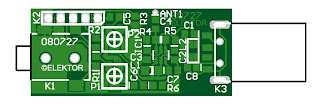. The circuit use no coils that have to be wound. This
r can be used to listen to your own music throughout your home. When this
used in the car, there is no need for a separate input to the car stereo to play back the music files from your
.
To keep the circuit simple as well as compact, it was decided to use a chip made by Maxim Integrated Products, the
MAX2606 [1]. This IC from the
MAX2605-
MAX2609 series has been specifically designed for
low-noise RF applications with a fixed frequency. The
VCO (
Voltage Controlled Oscillator) in this IC uses a
Colpitts oscillator circuit. The
variable-capacitance (varicap) diode and feedback capacitors
for the tuning have also been integrated on this chip, so that you only need an external inductor to fix the central oscillator frequency.
It is possible to fine-tune the frequency by varying the voltage to the varicap. Not much is demanded of the inductor, a type with a relatively low Q factor (35 to 40) is sufficient according to Maxim. The supply voltage to the IC should be between 2.7 and 5.5 V, the current consumption is between 2 and 4 mA. With values like these it seemed a good idea to
supply the circuit with power from a USB port.
A common-mode choke is connected in series with the USB connections in order to avoid interference between the circuit and the PC supply. There is not much else to the circuit. The
stereo signal connected to K1 is combined via R1 and R2 and is then passed via volume control P1 to the Tune input of IC1, where it causes the carrier wave to be frequency modulated. Filter R6/C7 is used to restrict the bandwidth of the audio signal. The setting of the frequency (across the whole
VHF FM broadcast band) is done with P2, which is connected to the 5 V supply voltage.
The
PCB designed uses resistors and capacitors with 0805 SMD packaging. The size of the board is only 41.2 x 17.9 mm, which is practically dongle-sized. For the aerial an almost straight copper track has been placed at the edge of the board. In practice we achieved a range of about 6 metres (18 feet) with this. There is also room for a 5-way SIL header on the board. Here we find the inputs to the 3.5 mm jack plug, the input to P1 and the supply voltage. The latter permits the circuit to be powered independently from the mains supply, via for example three AA batteries or a Lithium button cell. Inductor L1 in the prototype is a type made by Murata that has a fairly high Q factor: minimum 60 at 100 MHz.
Take care when you solder
filter choke L2, since the connections on both sides are very close together. The supply voltage is connected to this, so make sure that you don’t short out the
USB supply! Use a resistance meter to check that there is no short between the two supply connectors before connecting the circuit to a USB port on a computer or to the batteries.
P1 has the opposite effect to what you would expect (clockwise reduces the volume), because this made the
board layout much easier. The deviation and audio bandwidth varies with the setting of P1. The maximum sensitivity of the audio input is fairly large. With P1 set to its maximum level, a stereo input of 10 mVrms is sufficient for the sound on the radio to remain clear. This also depends on the setting of the
VCO. With a higher tuning voltage the input signal may be almost twice as large (see VCO tuning curve in the data sheet). Above that level some audible distortion becomes apparent. If the attenuation can’t be easily set by P1, you can increase the values of R1 and R2 without any problems.
Measurements with an
RF analyzer showed that the third harmonic had a strong presence in the transmitted spectrum (about 10 dB below the fundamental frequency). This should really have been much lower. With a low-impedance source connected to both inputs the bandwidth varies from 13.1 kHz (P1 at maximum) to 57 kHz (with the wiper of P1 set to 1/10).
In this circuit the
pre-emphasis of the input is missing. Radios in Europe have a built-in
de-emphasis network of 50 μs (75 μs in the US). The sound from the radio will therefore sound noticeably muffled. To correct this, and also to stop a
stereo receiver from mistakenly reacting to a
19 kHz component in the audio signal, an enhancement circuit Is published elsewhere in this issue (
Pre-emphasis for FM Transmitter, also with a PCB). Author:
Mathieu Coustans, Elektor Magazine, 2009MP3 FM Transmitter Parts List Resistors (all SMD 0805)
R1,R2 = 22kΩ
R3 = 4kΩ7
R4,R5 = 1kΩ
R6 = 270Ω
P1 = 10kΩ preset, SMD (TS53YJ103MR10 Vishay Sfernice, Farnell # 1557933)
P2 = 100kΩ preset, SMD(TS53YJ104MR10 Vishay Sfernice, Farnell # 1557934)
Capacitors (all SMD 0805)
C1,C2,C5 = 4μF7 10V
C3,C8 = 100nF
C4,C7 = 2nF2
C6 = 470nF
InductorsL1 = 390nF, SMD 1206 (LQH31HNR39K03L Murata, Farnell # 1515418)
L2 = 2200Ω @ 100MHz, SMD, common-mode choke, 1206 type(DLW31SN222SQ2L Murata, Farnell #1515599)
SemiconductorsIC1 = MAX2606EUT+, SMD SOT23-6 (Maxim Integrated Products)
MiscellaneousK1 = 3.5mm stereo audio jack SMD (SJ1-3513-SMT
CUI Inc, DIGI-Key # CP1-3513SJCT-ND)
K2 = 5-pin header (only required in combination with 090305-I pre-emphasis circuit)
K3 = USB connector type A, SMD (2410 07 Lumberg, Farnell # 1308875)
Notice. The use of a
VHF FM transmitter, even a low power device like the one described here, is subject to radio regulations and may not be legal in all countries.

















